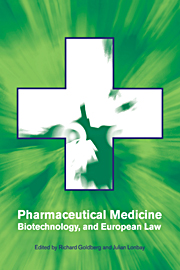Book contents
- Frontmatter
- Contents
- Notes on the contributors
- Preface
- Foreword by Francis G. Jacobs
- Editors' note
- Table of cases
- Table of treaties, European legislative instruments and national legislation
- Introduction
- Part I Free movement of goods and persons, competition and intellectual property
- 1 The free movement of goods I: pharmaceuticals, patents and parallel trade
- 2 The free movement of goods II: pharmaceuticals, trade marks and parallel imports
- 3 The free movement of health care professionals in the European Community
- 4 EC competition law, pharmaceuticals and intellectual property: recent developments
- Part II European drug regulation
- Part III Biotechnology
- Part IV Product liability and transnational health care litigation
- Index
4 - EC competition law, pharmaceuticals and intellectual property: recent developments
from Part I - Free movement of goods and persons, competition and intellectual property
Published online by Cambridge University Press: 24 October 2009
- Frontmatter
- Contents
- Notes on the contributors
- Preface
- Foreword by Francis G. Jacobs
- Editors' note
- Table of cases
- Table of treaties, European legislative instruments and national legislation
- Introduction
- Part I Free movement of goods and persons, competition and intellectual property
- 1 The free movement of goods I: pharmaceuticals, patents and parallel trade
- 2 The free movement of goods II: pharmaceuticals, trade marks and parallel imports
- 3 The free movement of health care professionals in the European Community
- 4 EC competition law, pharmaceuticals and intellectual property: recent developments
- Part II European drug regulation
- Part III Biotechnology
- Part IV Product liability and transnational health care litigation
- Index
Summary
Introduction
The application of the EC competition rules to the pharmaceutical sector has been the subject of considerable commentary and analysis in recent years. This is partly due to the intrinsic importance of the subject from a practical as well as a more theoretical or academic perspective, but is perhaps also to be attributed to the fact that the organisation and practices of the pharmaceutical industry have produced a rich seam of European legal problems, often raising many novel issues. Indeed the doctrines applicable to parallel imports have largely been developed through the application of the rules on free movement (Articles 28–30 (ex 30–6) EC) and competition (Articles 81–2 (ex 85–6) EC) to this complex legal sector.
This chapter cannot attempt to cover the many and varied aspects of the application of EC competition law and principles in full. Instead it focuses on several key recent developments in the case law of the European Courts, with a view to determining whether it is possible to explain or continue to explain these developments by peculiarities in the underlying policies on which the relevant EC rules are based. This contribution will therefore look in some detail at the development of the case law with respect to parallel imports. This is of course only one aspect of EC pharmaceutical law. Important matters relating to the development of the centralised authorisation procedure are not covered here, nor are issues relating to product safety and efficacy or advertising rules, or the many facets of the sector which are now subject to increasingly complex bodies of secondary law.
- Type
- Chapter
- Information
- Pharmaceutical Medicine, Biotechnology and European Law , pp. 76 - 90Publisher: Cambridge University PressPrint publication year: 2001



